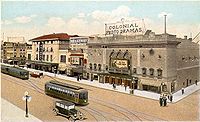
Richmond Union Passenger Railway
Encyclopedia

Richmond, Virginia
Richmond is the capital of the Commonwealth of Virginia, in the United States. It is an independent city and not part of any county. Richmond is the center of the Richmond Metropolitan Statistical Area and the Greater Richmond area...
, was the first practical electric trolley (tram)
Tram
A tram is a passenger rail vehicle which runs on tracks along public urban streets and also sometimes on separate rights of way. It may also run between cities and/or towns , and/or partially grade separated even in the cities...
system, and set the pattern for most subsequent electric trolley systems around the world. It is an IEEE milestone in engineering.
The Richmond system was not the first attempt to operate an electric trolley. According to the IEEE, there were at least 74 earlier attempts to provide electric trolley service in over 60 communities in North America
North America
North America is a continent wholly within the Northern Hemisphere and almost wholly within the Western Hemisphere. It is also considered a northern subcontinent of the Americas...
, the United Kingdom
United Kingdom
The United Kingdom of Great Britain and Northern IrelandIn the United Kingdom and Dependencies, other languages have been officially recognised as legitimate autochthonous languages under the European Charter for Regional or Minority Languages...
, and continental Europe
Europe
Europe is, by convention, one of the world's seven continents. Comprising the westernmost peninsula of Eurasia, Europe is generally 'divided' from Asia to its east by the watershed divides of the Ural and Caucasus Mountains, the Ural River, the Caspian and Black Seas, and the waterways connecting...
. However, these earlier attempts were not reliable enough to replace the existing animal-powered trolleys.
The Richmond system was designed by Frank Julian Sprague. After trials in late 1887, it began regular operation on February 2, 1888, with 10 streetcars. Electric power was supplied through overhead trolley wires (450 volt
Volt
The volt is the SI derived unit for electric potential, electric potential difference, and electromotive force. The volt is named in honor of the Italian physicist Alessandro Volta , who invented the voltaic pile, possibly the first chemical battery.- Definition :A single volt is defined as the...
s) for two 7.5 hp motors on each car. Large cars weighed 6900 pounds, provided 40 seats, and carried up to 100 passengers; small cars weighed 6700 pounds with 22 seats and up to 65 passengers. Running speed was 7.5 miles/hour, with 15 miles/hour as a maximum speed. By June 1888 the system contained 40 cars running on some 12 miles (19.3 km) of track, including steep grades, and with 30 curves.
Its success proved that electric traction was both safe and reliable. The Boston
Boston
Boston is the capital of and largest city in Massachusetts, and is one of the oldest cities in the United States. The largest city in New England, Boston is regarded as the unofficial "Capital of New England" for its economic and cultural impact on the entire New England region. The city proper had...
City Council, after inspecting Richmond's system on September 7, 1888, approved construction the second such project by the West End Street Railway. Boston's trolley was closely patterned upon Richmond's, and again demonstrated its practicality. By 1895 almost 900 electric street railways and nearly 11000 miles (17,702.7 km) of track had been built in the United States, and in a little over a decade animal-powered street railways had essentially vanished.
Richmond's electric trolley service ended on November 25, 1949.

